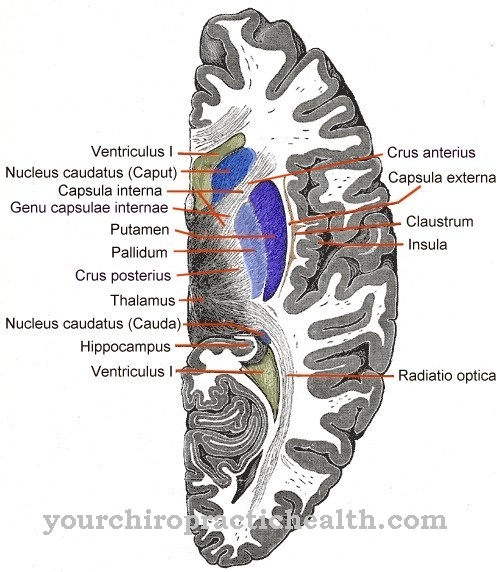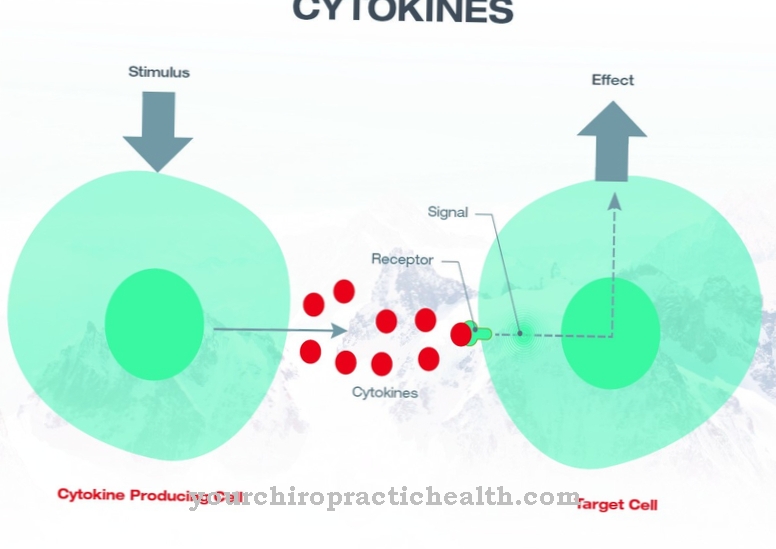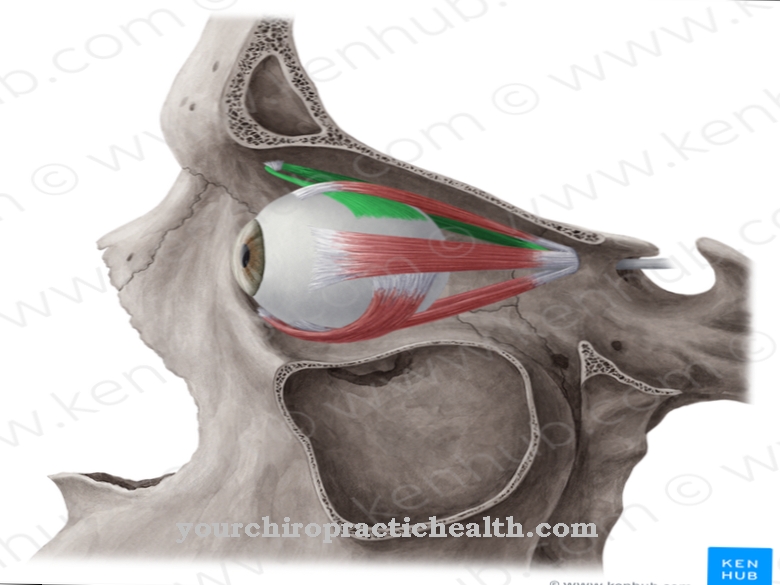Of the Auricularis magnus nerve is a sensitive nerve of the neck plexus. The nerve supplies the dorsal ear skin and parts of the scalp sensitively. Damage to the nerve results in sensory disorders.
What is the auricularis magnus nerve?
The cervical plexus is better known among medical professionals as the cervical plexus. It consists of the anterior branches or rami of the spinal nerves from segments C1 to C4 and also carries parts of spinal nerves from segment C5. The nerve branches of the plexus run between the anterior scalenus muscle and the medius scalenus muscle down into the deeper neck region.
In addition to motor and mixed nerves, the cervical plexus carries a number of purely sensory nerves. This includes, for example, the auricularis magnus nerve, which is also known as the large ear nerve. The nerve originates from the second and third neck segments C2 and C3 in the spinal cord and is therefore a sensitive spinal nerve whose original fibers articulate together with other cervical nerves in the cervical plexus. Sensitive nerves show an afferent course. They transport excitation ascending in the direction of the central nervous system, while efferent nerves direct excitation in the other direction and thus out of the central nervous system.
The auricularis magnus nerve is the largest nerve of the ascending nerve branches in the cervical plexus. Since the auricularis magnus nerve does not consist of just one ramus, the term “nerve” is actually misleading. More specifically, it is a question of two nerve branches of the same nerve.
Anatomy & structure
The auricularis magnus nerve starts from the anterior branches of the second and third spinal nerves. From there, the sensitive nerve winds around the sternocleidomastoid muscle.
In the punctum nervosum or Erb's point, the nerve reappears together with the nervus transversus colli, nervus occipitalis minor and nervi supraclaviculares and appears on the posterior edge of the skeletal muscle. In its course, the nerve, like many other nerves in the cervical plexus, penetrates the superficial cervical fascia. After perforation, it continues on the muscle in a cranial direction under the platysmas and reaches the parotid gland. At this point the auricularis magnus nerve divides into an anterior and a posterior branch or ramus.
In the area of the parotid, the sensitive nerve cord communicates with fibers of the facial nerve. The auricularis magnus nerve is a purely sensory nerve. Motor nerves can never be purely motor efferent, but always contain sensitive afferent fibers. In the case of sensitive nerves, however, the exclusive use of the sensitive fiber type is the rule. Like all other nerve fibers, the auricularis magnus nerve is surrounded by glial cells and corresponds to an extension of nerve cells.
Function & tasks
The function of sensory nerves is to transport excitation into the central nervous system. The sensory nerves are connected to so-called receptors in the periphery.The receptors perceive stimuli such as pressure, touch, temperature and pain and, depending on the stimulus intensity, transmit these stimuli into the language of the central nervous system.
This happens via the formation of an action potential, which finally migrates along the afferent sensitive nerve fibers out of the tissue into the central nervous system. This is where the final processing of the signal begins and the stimulus perception, for example, reaches consciousness. Purely sensitive nerves are not intended to carry deeply sensitive information. The deep sensitivity consists of perception of stimuli from the muscle spindle and the Golgi tendon organ. It is made up of information about the current position of joints and muscles and is transported to the central nervous system via the ascending components of mixed sensory-motor nerves.
The purely sensitive nerves have nothing to do with the deep sensitivity. The auricularis magnus nerve only transmits temperature, pain and touch stimuli. It takes over the sensitive innervation of the dorsal skin parts in the area of the auricle and the scalp behind the ear. In addition, it supplies the skin over the mastoid process in a sensitive manner and also innervates an area of skin above the parotid gland and the masseter muscle.
Diseases
Because of its extraordinary length, the auricularis magnus nerve is used as a donor nerve in reconstructive surgery. In reconstructive surgical interventions, it is used from time to time as an interposal for the reconstruction of shorter nerve defects. The auricularis magnus nerve itself can also be affected by defects.
In the case of a lesion of his tissue, sensory disturbances appear in the supply areas mentioned above. These disorders can manifest themselves in different ways. In addition to numbness, abnormal sensations such as disturbed pain or warm and cold sensations can occur. A persistent tingling sensation is also a possible symptom. Peripherally mediated sensory disorders occur, for example, when the cervical nerve plexus is jammed between the anterior scalenus and the scalenus. This can be the case after the two muscles have increased in size, for example due to excessive stress.
In the context of polyneuropathies, peripherally mediated sensory disorders can also occur, which can be traced back to a demyelination of peripheral nerve branches. Such demyelination degenerates the insulating cells around the nerves. Stimuli are still detected, but the excitation generated in response to stimulus perception is partially or completely lost on the way to the central nervous system. Trauma, peripheral inflammation, infections or malnutrition and poisoning can also result in sensitivity disorders.
Centrally mediated sensory disturbances of the auricularis magnus nerve are usually associated with injuries to the associated spinal nerve and can be attributed to spinal cord infarctions or the autoimmune disease multiple sclerosis, for example.



























